Datebook: The Hammer’s new acquisitions, a daylong performance in Echo Park, sculptures of female guerrillas
- Share via
A museum’s new acquisitions. A vocalist’s daylong performance at Echo Park Lake. And an installation inspired by a ‘60s French novel about a world where women fight to take over society. Here are nine exhibitions and events to check out in the coming week:
“Living Apart Together: Recent Acquisitions,” at the Hammer Museum. A new installation gathers recent additions to the museum’s permanent collection — gifts from donors and artists, as well as museum acquisitions — with an emphasis on art made over the last decade in Los Angeles. A good opportunity to see what’s been cooking in the old hometown. Opens Sunday and runs through Aug. 27. 10899 Wilshire Blvd., Westwood, Los Angeles, hammer.ucla.edu.
Carmina Escobar, “Fiesta Perpetua!,” at Echo Park Lake. Machine Project, the experimental arts space based in Echo Park, is staging a daylong performance at Echo Park Lake with experimental vocalist Carmina Escobar and a pair of Oaxacan youth brass bands: Banda Filarmónica Grandeza Oaxaqueña and Banda Filarmónica Maqueos Music. Also in the mix is a Japanese Butoh dancer known as Oguri. Performances, which will take place on and around the lake, will kick off Saturday at sunrise (5:48 a.m.) and will continue at regular intervals throughout the day until sunset (7:52 p.m.). The piece is inspired by elements of ritual and landscape — and sounds like an absolute must-see. This Saturday from sunrise to sunset. 751 Echo Park Ave., Echo Park, Los Angeles, machineproject.com.
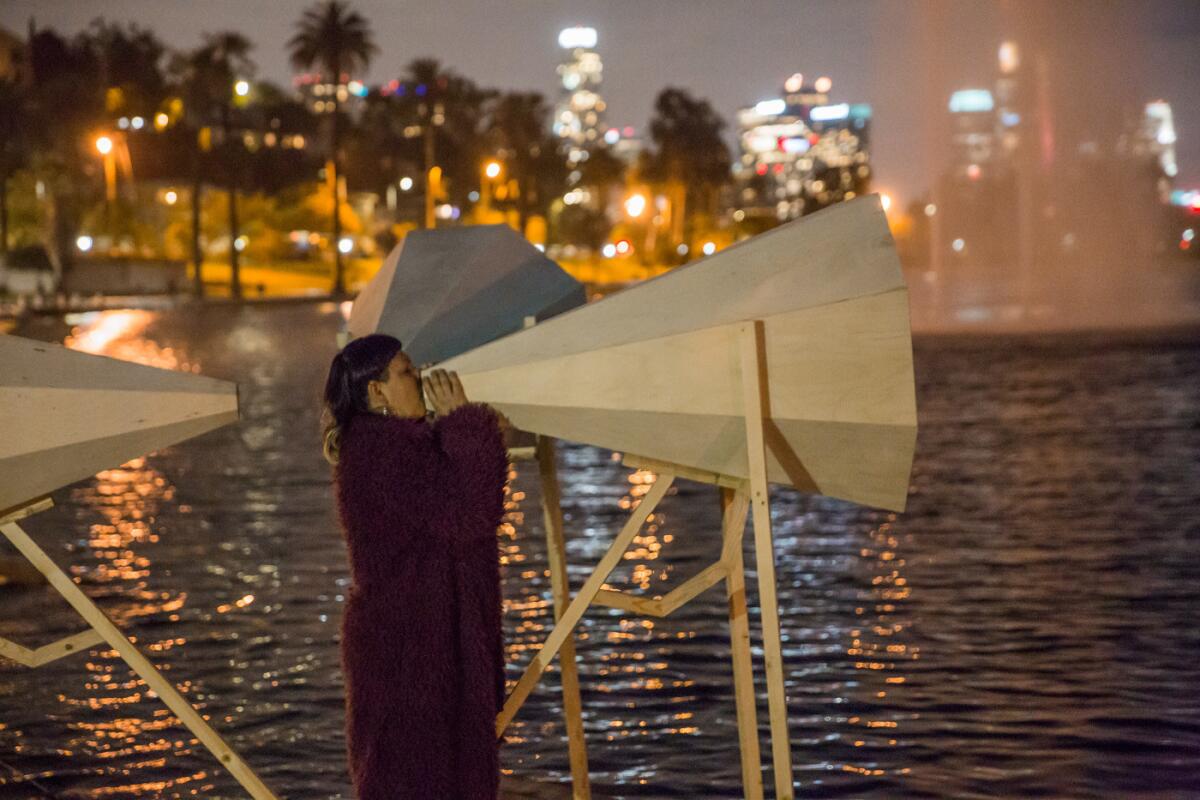
Mai-Thu Perret, “Féminaire,” at David Kordanksy Gallery. The Geneva-born artist has created an installation inside Kordanksy Gallery that is inspired by the 1969 novel by Monique Wittig “Les Guérillères,” which tells a story of a war waged by women who are trying to take over society. The show includes a series of sculptural female warriors, as well as ceramic pieces that evoke battle memorials. Sounds like the perfect show for this political moment. Also on view will be an exhibition of 12 new paintings by Lesley Vance, whose abstracted works often hark to the annals of art history while remaining resolutely modern. Opens Friday at 6 p.m. and runs through July 1. 5130 W. Edgewood Place, Mid-Wilshire, Los Angeles, davidkordanskygallery.com.
“Vernacular Environments, Part 1,” at Edward Cella Art & Architecture. A group show brings together works from the 1960s to the present in ways that explore issues of environment and the ways in which humans shape it. Serving as a cornerstone to the exhibition is Robert Smithson’s film “Spiral Jetty,” about his renowned piece of land art of the same name. Other artists in the show include sculptor Dan Graham, composer and video artist Christian Marclay, photographer Stephen Berens and conceptualist Clarissa Tossin, who created a floating sculpture based on Brazil’s presidential palace out of empty cement bags, a nod to the Brazilian capital’s informal settlements. Opens Saturday at 6 p.m. and runs through July 15. 2754 S. La Cienega Blvd., Culver City, edwardcella.com.
Anna Sew Hoy, “Psychic Body Grotto,” at Los Angeles State Historic Park. The Los Angeles sculptor recently unveiled a new public work, courtesy of the Los Angeles Nomadic Division, at L.A.’s newest park. This weekend, there will be a special opening event to mark the unveiling, including performances and other actions by groups such as Ethernet, LA Fog and Corey Fogel, who will turn the sculpture into an instrument of sorts. Plus, John Tain and Carol Cheh from the art radio station KCHUNG will be on site with a live broadcast. Sounds like a party. This Sunday at 4 p.m. 1245 N. Spring St., Chinatown, Los Angeles, nomadicdivision.org.
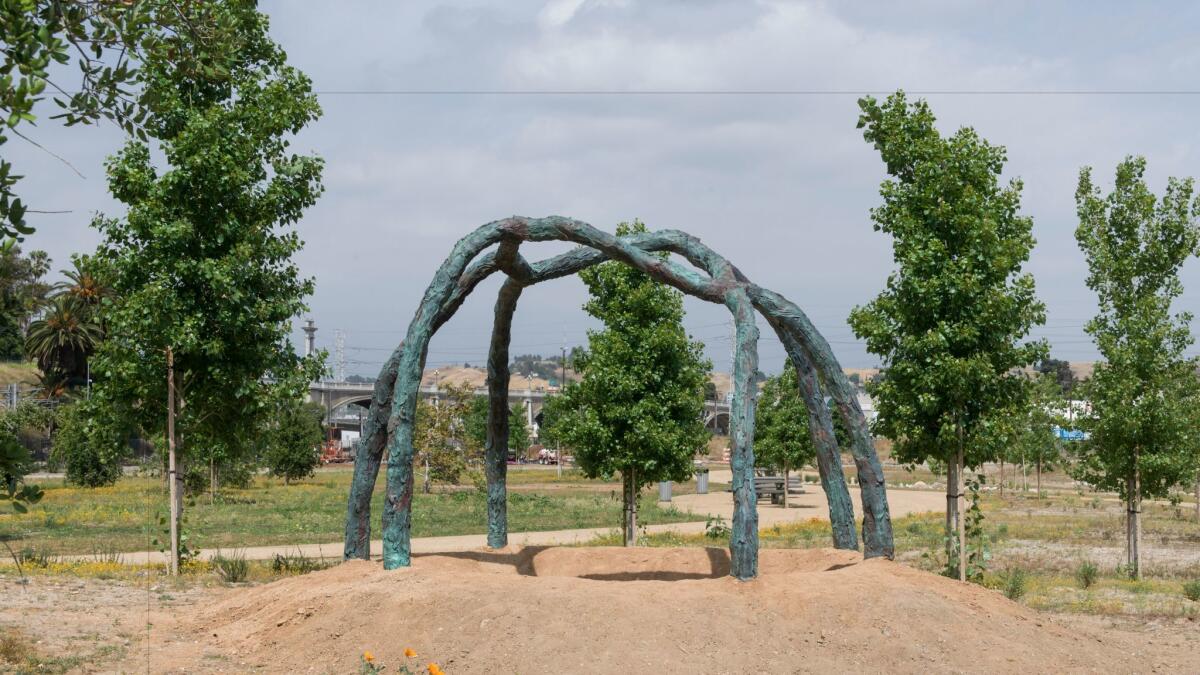
John Baldessari, “Eight Colorful Inside Jobs,” at Mixografia. This exhibition features works from the more than two-decade-long collaboration between the renowned California conceptualist and the innovative printers at Mixografia, known for creating paper works with deep texture (or illusions of texture). The series on view presents shapes in simple forms in solid basic colors. Opens Saturday at 4 p.m. and runs through July 15. 1419 E. Adams Blvd., Central-Alameda, Los Angeles, mixografia.com.
“Focus Group,” at Charlie James Gallery. Artist Michael Shaw, who hosts the arts podcast “The Conversation,” has put together a group show inspired by curator and author Nato Thompson’s book “Seeing Power,” which notes that art is either “ambiguous” or “didactic.” Shaw has put together works that riff on these ideas — but by placing these works in close proximity with one another, he warps and changes their meanings. Opens Saturday at 6 p.m. and runs through July 8. 969 Chung
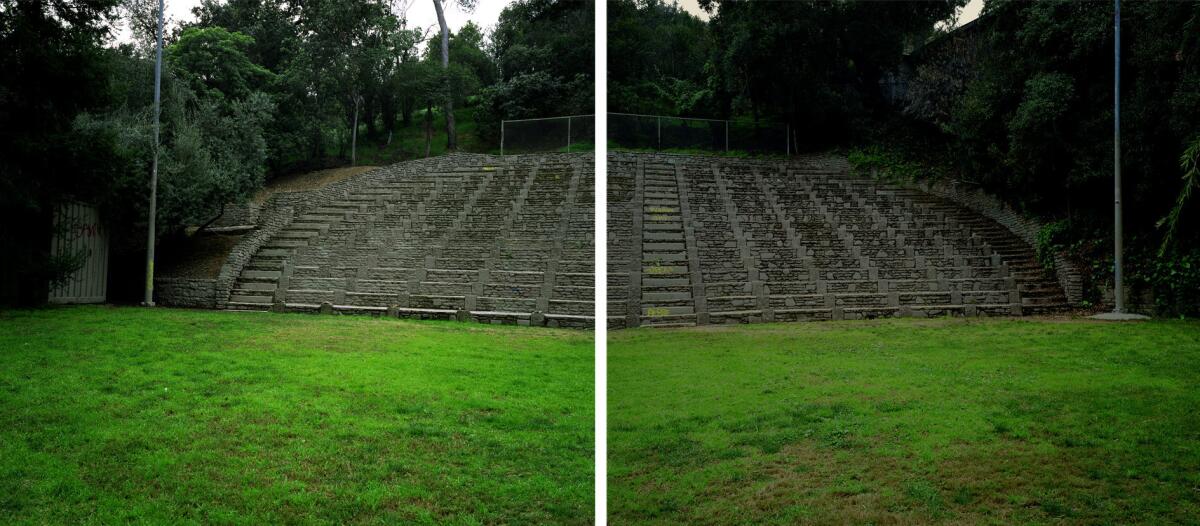
Linda Sue Price, “Enlightened Systems,” at TAG Gallery. The longtime artist-run space in Santa Monica has relocated from its digs at Bergamot Station to a new space in Mid-Wilshire near
Mark Gonzales, “Fower Plower,” at HVW8. A new show of paintings by the L.A.-born skater and painter riffs on color, humor and the geometries of forebears such as Paul Klee with a series of new works that feature faces, and naturally, flowers. Opens Friday at 6 p.m. and runs through June 20. 661 N. Spaulding Ave., Fairfax District, Los Angeles, hvw8.com.
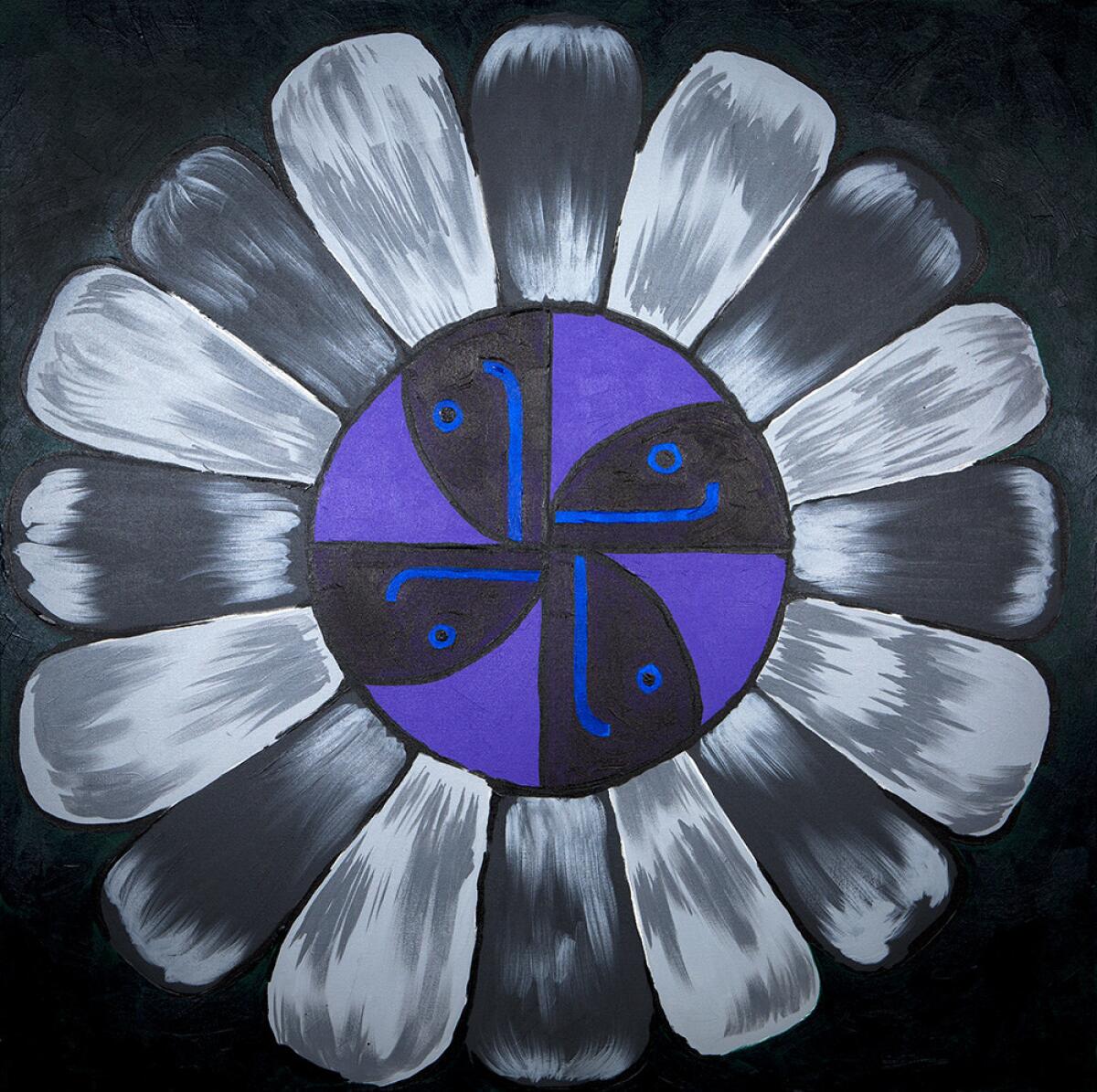
Last chance
Elizabeth Neel, “Claw Hammer,” and Stanya Kahn, “Stand in the Stream,” at Susanne Vielmetter Los Angeles Projects. Neel, a New York-based painter, is known for layering brushed and rolled paint with expressionistic spills onto large raw canvases for lushly tinted abstractions that often evoke both earthy phenomena and architectural forms. Separately, Vielmetter is also showing L.A.-based video artist Kahn, who is known for dizzying works that build tension while upending narrative. Her latest film, shot over six years, mixes a bevy of images shot on a variety of devices that observe strangers in public spaces. Through Saturday. 6006 Washington Blvd., Culver City, vielmetter.com.
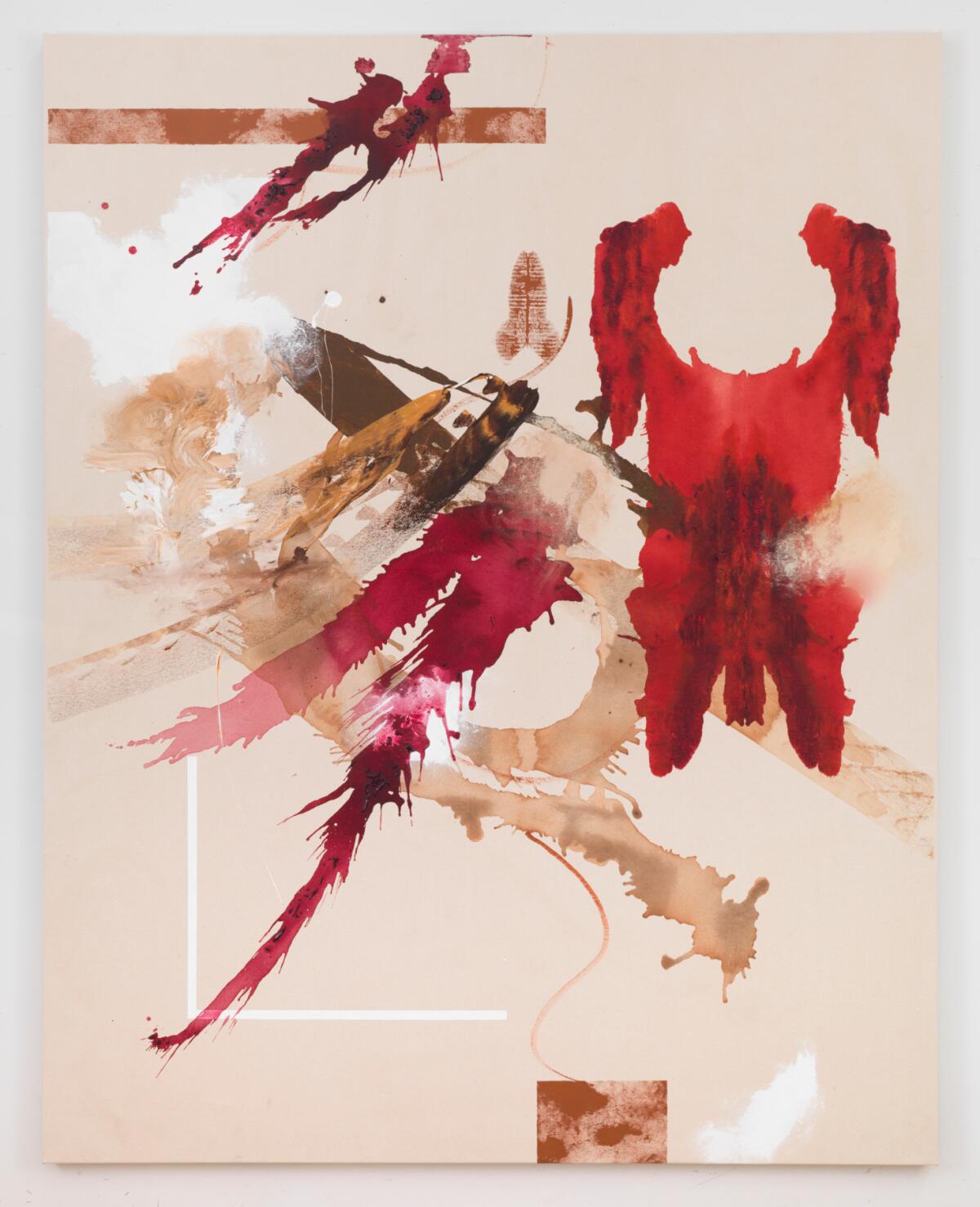
Jason Rhoades, “Installations, 1994-2006,” at Hauser Wirth & Schimmel. The Los Angeles artist — known for sprawling, ribald installations made with everything from neon to cardboard to peas — often touched on issues of religion, sex and commerce in his work. This show, his first comprehensive survey in Los Angeles, brings together six of his most significant installations, including a tribute to sculptor Constantin Brancusi and a massive, sexually charged piece that features 240 neon words that describe female genitalia — a temple-like set-up where the viewer is invited to be wildly seduced. Through Sunday. 901 E. 3rd St., downtown Los Angeles, hauserwirthschimmel.com.
Manuel Ocampo & Irene Iré, “Monument to the Pathetic Sublime,” at Coagula Curatorial. Ocampo, a Filipino artist who will be representing his native country at the 2017 Venice Biennale, and Iré, a painter who hails from Spain, take on Goya’s 18th century print series “Los Caprichos,” about the vanities and absurdities of Spanish society. The two have created a series of works inspired by Goya that take the acid eye and black humor of the Spanish master and apply it to today’s society. Through Sunday. 974 Chung King Road, Chinatown, Los Angeles, coagulacuratorial.com.
“Dreamland: A Frank Romero Retrospective,” at the Museum of Latin American Art. The first museum retrospective of the storied Los Angeles painter brings together more than 200 works from throughout his career — pieces that frequently contend with various aspects of the urban experience, in particular that of L.A. The show covers all periods of his more than five-decade-long career, including his early works, pieces from his time with the collective Los Four in the 1970s and ’80s, his large-scale paintings and murals, as well as his more recent work in neon and ceramics. Through Sunday. 628 Alamitos Ave., Long Beach, molaa.org.
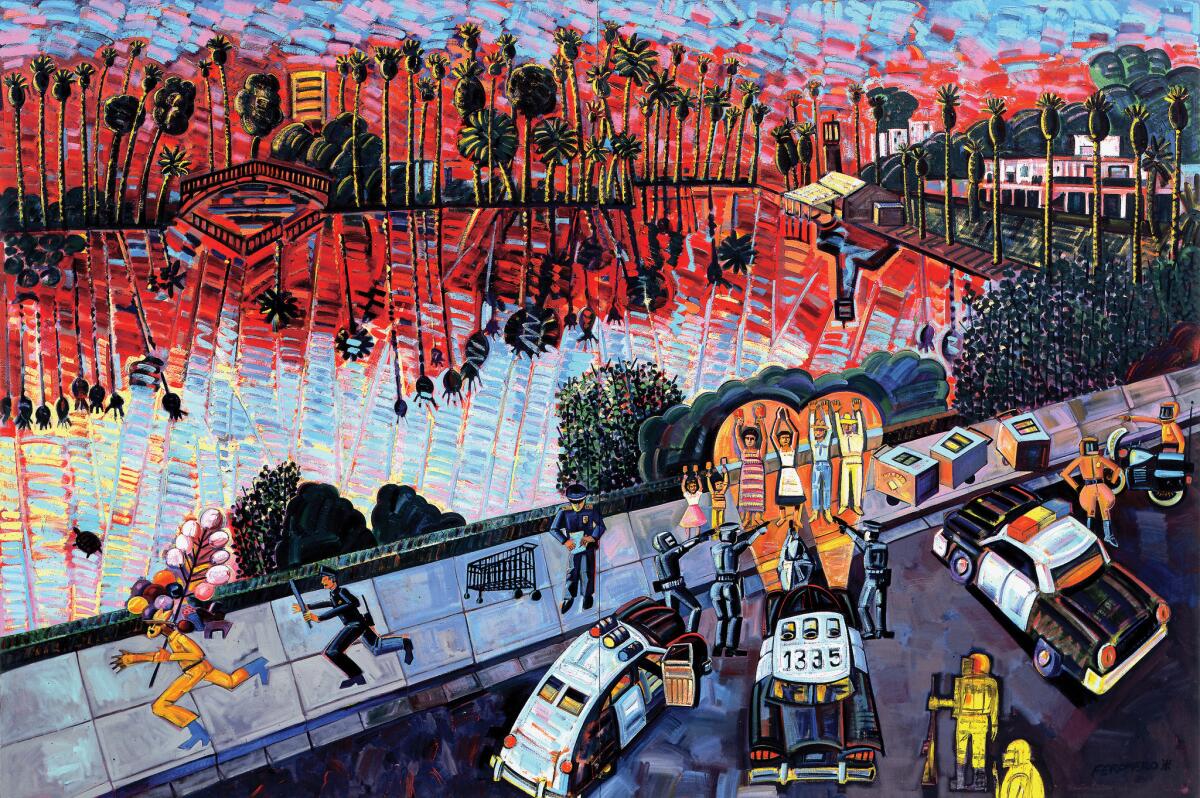
“Transcultural Dialogues: The Books of Mesoamerica and Colonial Mexico,” at JFK Library at Cal State Los Angeles. Tied to a special symposium that honored the work of influential Mexican archaeologist Eduardo Matos Moctezuma, the university has put together an exhibition of important books dating to the 17th century, including historical chronicles and reproductions of Mesoamerican codices. Through Sunday. 5151 State University Drive, East Los Angeles, calstatela.edu.
Ongoing exhibitions
“Figure/ Landscape,” at Zevitas Marcus. A group show explores two very old themes in art: the figure and landscape, and the ways in which the two are related to each other. This includes more traditional viewpoints, as well as more abstracted, exaggerated and conceptual portrayals. Through May 27. 2754 S. La Cienega Blvd., Culver City, zevitasmarcus.com.
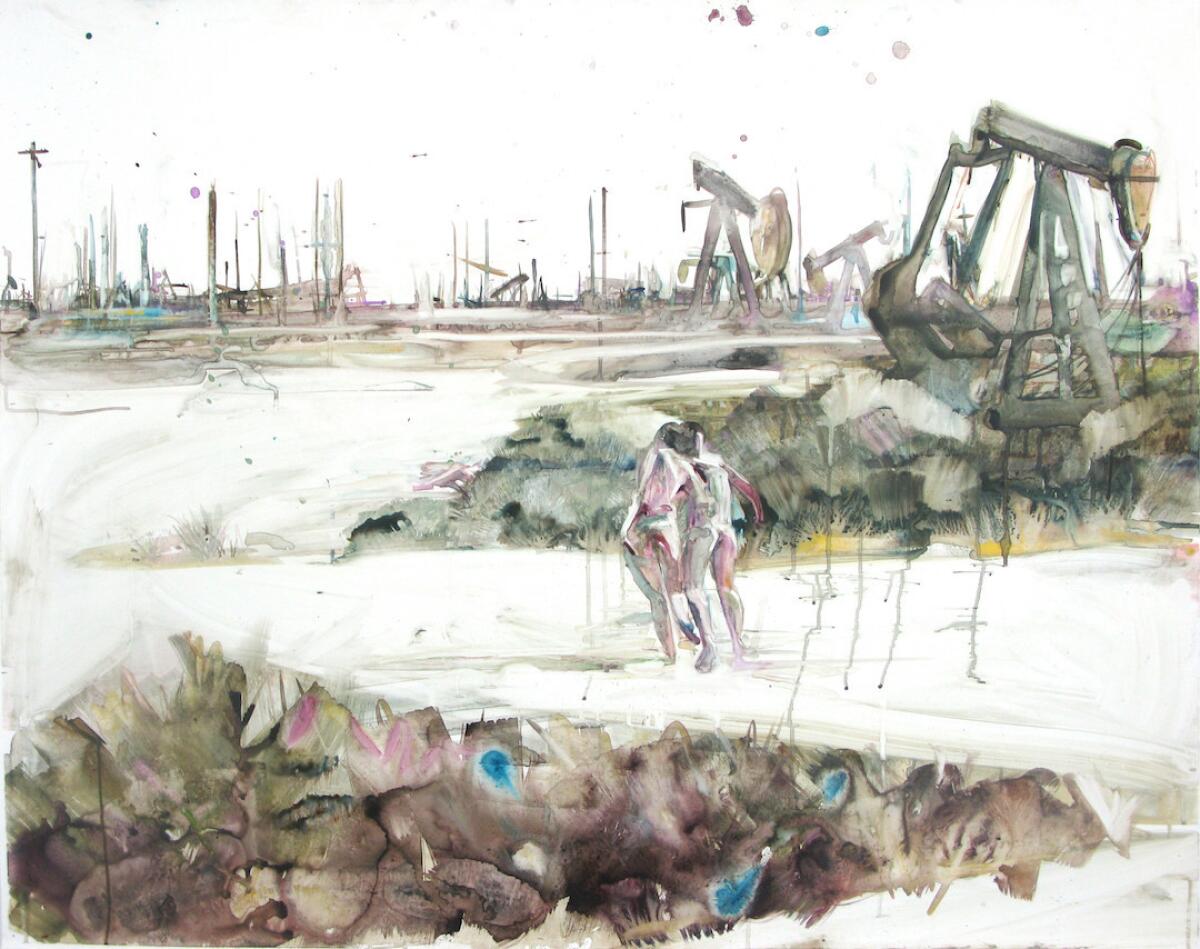
“Projections Part III: Post America,” at Roberts & Tilton. Organized by Aaron Rose, this exhibition brings together a collection of hard-to-see films, including director Franz Bromet’s 1981 documentary “Surf Punks” and the controversial 1983 doc “Seventeen,” which follows a teenager from Muncie, Ind., on her last year in school. Check the website for a list of screening times. Through May 27. 5801 Washington Blvd., Culver City, robertsandtilton.com.
“The Basilisk,” at Nicodim Gallery. A bewitching group show organized by Aaron Moulton takes themes of the supernatural and the quasi-religious and uses it to Cuisinart a staggering array of cultural artifacts — from paintings and costumes from the space-alien obsessed Unarius Academy to a video installation by Diana Thater, a contemporary video artist who recently had a one-woman show at LACMA. There are myriad other wonders to behold, such as a video of Bob Ross fed into the hallucinatory Deep Dream program and a painting by “painter of light” Thomas Kinkade displayed on cosmic wallpaper created by artist Mungo Thomson. This is not to be missed. Through May 27. 571 S. Anderson St., Suite 2, Boyle Heights, Los Angeles, nicodimgallery.com.
Liz Young, “Of Blood and Dirt,” at Pøst. Young often plays, in wry and mordant ways, with elements of the human and the animal, presented in installations that evoke a cabinet of curiosities — albeit in surreal configurations. Of particular interest for this exhibition are objects that hark back to the ideals of the American West: Hunting targets, taxidermy, wood-burning brands and other secondhand objects that in death are filled with a strange afterlife. Other elements engage the artist’s interest in text, which has historically drawn from works by the likes of Sam Sheppard and Annie Proulx. Through May 27; after May 20, the gallery will be open by appointment only. A closing reception will be held on May 27 at 7 p.m. 1206 Maple Ave., No. 515, downtown Los Angeles, facebook.com/NotPOST.
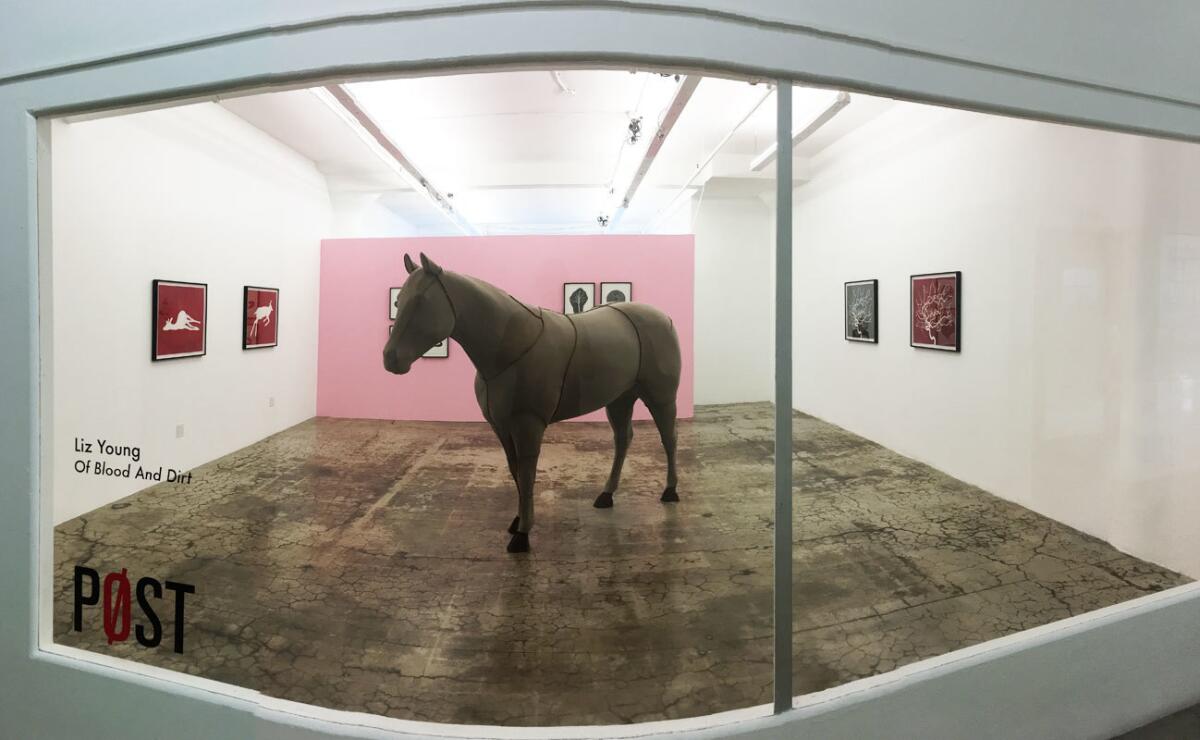
Lari Pittman / Silke Otto-Knapp, “Subject, Predicate, Object,” at Regen Projects. This show features new work by two L.A.-based artists. This includes 10 large-scale artist books produced by Pittman, which will be displayed in an array of tables designed by L.A. architect Michael Maltzan. Also on view: a group of new paintings by Otto-Knapp, which take on elements of form and landscape in muted layers of paint. Sounds like two great tastes that taste great together. Through May 27. 6750 Santa Monica Blvd., Hollywood, regenprojects.com.
Phung Huynh, “Pretty Hurts,” at CB1 Gallery. The artist employs kitsch painting techniques — of the sort found in Chinatown gift shops — to explores issues of body and modification (specifically through plastic surgery) among Asian women. The images are a searing yet comic hybrid of the strange things women do to their bodies in the name of beauty. In a separate exhibition, the gallery is showing the painted, laser-cut acrylic works of Osvaldo Trujillo, who buries all manner of images in his delicate lace-like patterns. Through May 27. 1923 S. Santa Fe, downtown Los Angeles, cb1gallery.com.
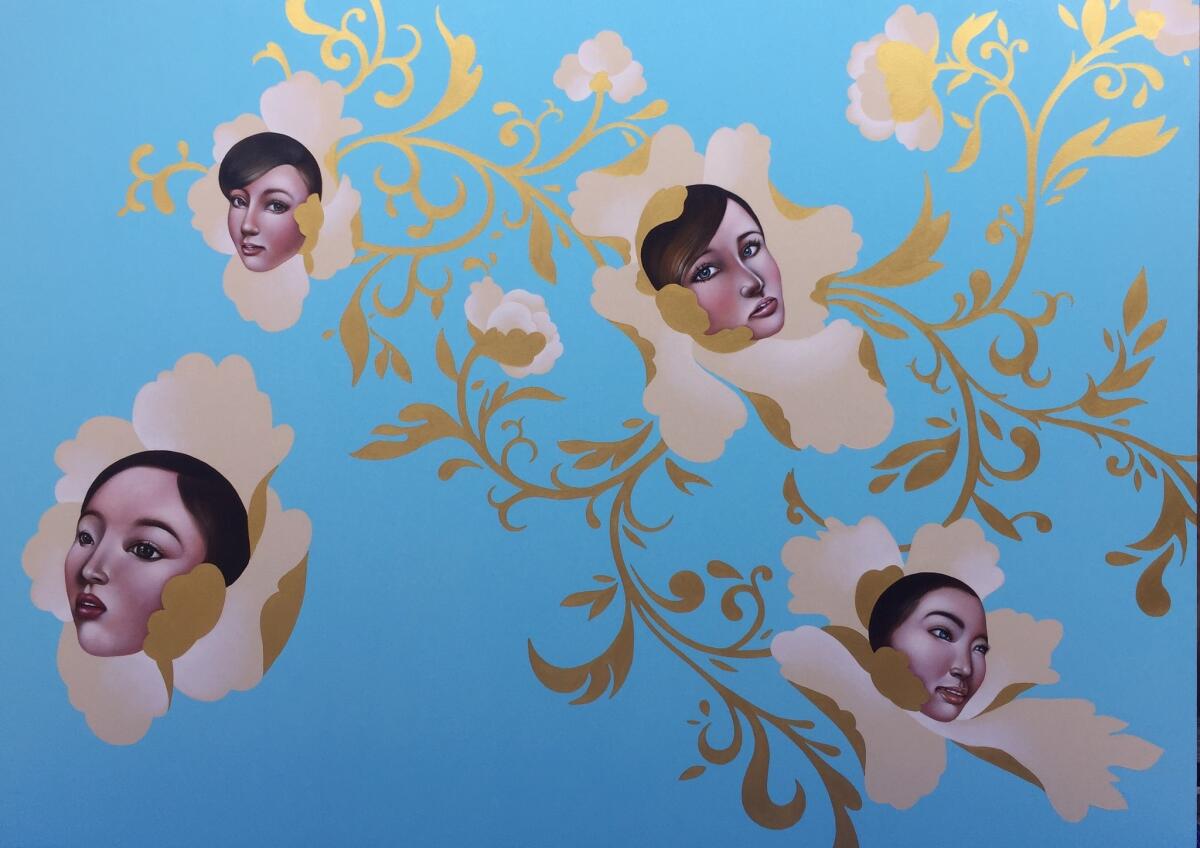
McDermott & McGough, “Hollywood (Homosexual) Hopeful,” at Team Gallery. Artists David McDermott and Peter McGough have been making art as a pair since the 1980s when they emerged out of New York’s East Village art scene. Since then, they have regularly produced work that employs found images from American mass media to explore issues of sexuality, bigotry and the fallout from the AIDS crisis. For this show, McDermott and McGough have turned their attention to the closeted man in Hollywood — perfect subject matter for Los Angeles. Through May 28. 306 Windward Ave., Venice, teamgal.com.
“Fefu and Her Friends,” presented at Hollyhock House by Circle X Theatre Co. When avant-garde Cuban-American playwright María Irene Fornés first produced the play “Fefu and Her Friends” in the 1970s, it took theater off the stage into various simultaneous locations around a building. Now this work will be presented at the Frank Lloyd Wright-designed Hollyhock House — the first ever work of live theater staged at the historic home, and one that will take full advantage of the setting. The play centers on a group of women planning a charitable event. Drama and intrigue abound. Weekend shows through May 28. Barnsdall Art Park, 4800 Hollywood Blvd., Hollywood, circlextheatre.org.

“Aaron G. Green and California Organic Architecture,” at the Palos Verdes Art Center. Green was an architect inspired by the complex patterns and rugged textures found in nature, and this exhibition, curated by architectural historian Alan Hess, gathers rare photographs, along with original architectural renderings and other materials, to show a school of modernism that turned away from the glass box in favor of more organic forms. Through May 28. 5504 West Crestridge Road, Palos Verdes, aarongreen.org and pvartcenter.org.
“Women of Abstract Expressionism” at the Palm Springs Museum of Art. The Abstract Expressionist movement has been widely regarded as a boys club, one bursting with the macho antics of painters such as
Graeme Mitchell, “Detached Pictures,” at Wilding Cran Gallery. The noted portrait photographer employs photography as a point of departure for a series of new paintings that show the ways in which photography (and its translation into other media) can leave a lot of questions hovering about what represents reality. Through May 28. 939 S. Santa Fe Ave., downtown Los Angeles, wildingcran.com.
“Non Fiction,” at the Underground Museum. An emotionally charged exhibition curated by the late Noah Davis in collaboration with the Museum of Contemporary Art in Los Angeles brings together works that explore issues of race and violence. This includes important works from
“Animating the Archives: The Woman’s Building,” at Avenue 50 Studio. In 1973, artist Judy Chicago, graphic designer Sheila Levrant de Bretteville and historian Arlene Raven launched the Woman’s Building in Los Angeles, a space that served as education center and exhibition space for feminist artists of all stripes. Now a new generation of artists is responding to that history. This exhibition =features the work of 15 contemporary artists and artist collectives, including Raquel Gutierrez, Johanna Breiding, Cindy Rehm and Hackers of Resistance, in dialogue with their feminist forebears. There will be public performances, readings and discussions, so keep an eye on the website for times and dates. Through June 3. 131 N. Avenue 50, Highland Park, Los Angeles, thewomansbuilding.org and avenue50studio.org.
“Signifying Form,” at the Landing Gallery. A beguiling exhibition organized by independent curator Jill Moniz (formerly of the California African American Museum) brings together sculpture by African American women from 1935 to the present. This puts works by esteemed figures such as Elizabeth Catlett, Betye Saar, Maren Hassinger and Senga Nengudi into an intergenerational dialogue with younger artists such as Brenna Youngblood. The show is united by a profound interest in material and its possibilities, be it wire, wood or buoyant plastic bags. Of particular interest is Alison Saar’s “Cakewalk,” a 1997 sculpture that consists of a life-size wood puppet of a black female figure — on view for the first time in Los Angeles. Viewers are allowed to move her limbs, becoming complicit in a long history of controlling black female bodies. Do not miss. Through June 3. 5118 W. Jefferson Blvd., West Adams, Los Angeles, thelandinggallery.com.
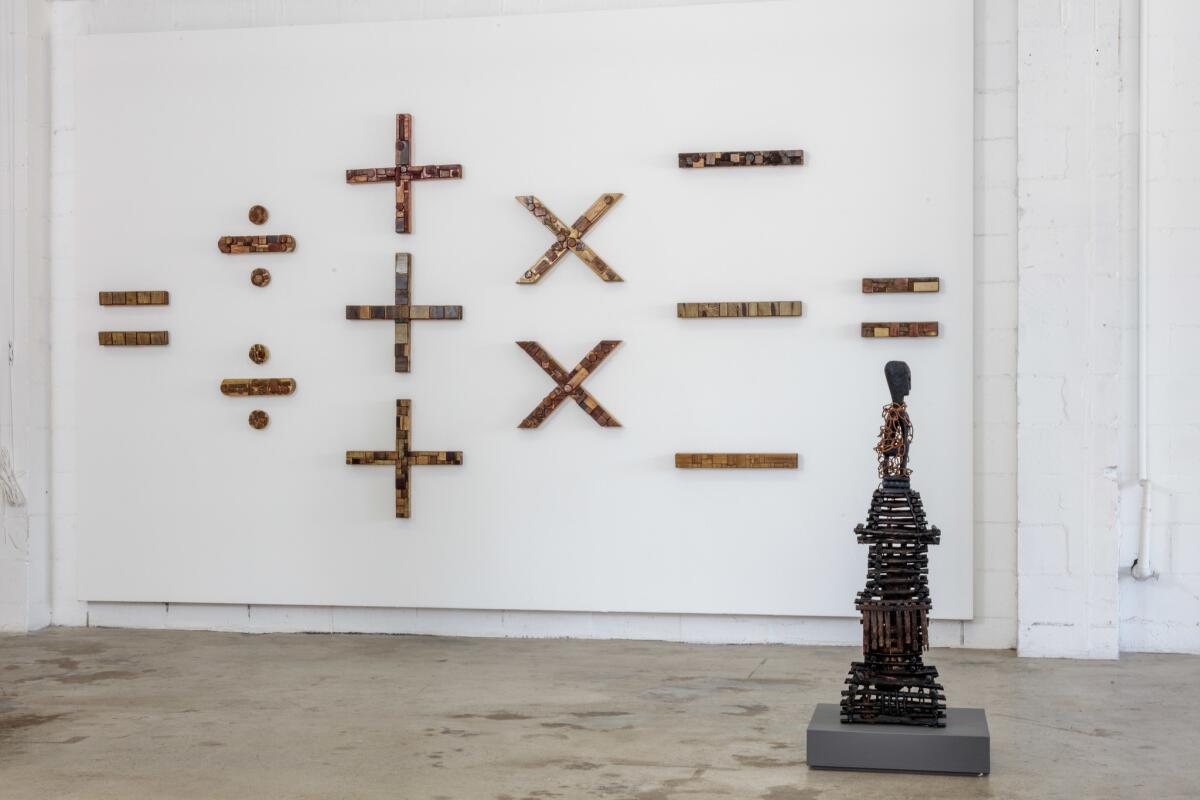
“1992: An Examination of the Iconography from the ‘92 Los Angeles Rebellion,” at Residency. A group show features work by L.A. artists such as Charles Dickson, Patrick Martinez and Tanya Bernard that explores the iconography of the 1992 Los Angeles riots by artists who lived through and saw the effects of those events. Through June 3. 310 E. Queen St., Inglewood, residencyart.com.
Shagha Ariannia, “Who Sings the Nation-State?” at the Vincent Price Art Museum. The artist, who was born in Tehran, looks at issues of citizenship, national identity and immigration through the lens of her own childhood in a video piece that also features related drawings and paintings. Through June 10. 1301 Cesar Chavez Ave., East Los Angeles, vincentpriceartmuseum.org.
Joaquin Boz, “New Work,” at Steve Turner. In his latest exhibition at Steve Turner, the Buenos Aires-based artist is presenting three monumental abstract paintings on wood panel. Expressive brushstrokes blend with hieroglyphic-style marks for works that seem to evoke aspects of landscape in the most distant ways. Through June 10. 6830 Santa Monica Blvd., Hollywood, steveturner.la.
“Wouldn’t it be nice if we could dream together,” at Diane Rosenstein Gallery. The Hollywood Gallery is marking its fifth anniversary with a group show of painting, sculpture, ceramics and more by 11 artists who offer a peek into alternate worlds. This includes work by sculptor Charles Fine, painter Daniel Gibson and Joe Ray, a painter intrigued by the astronomic. Through June 10. 831 N. Highland Ave., Hollywood, dianerosenstein.com.
“Paperworks: Selections From the Permanent Collection, at the California African American Museum. Drawing from the museum’s collection of works on paper, which covers a period that dates two centuries — from 1800 to 2000, this group exhibition gathers collages, drawings, paintings and other works by important figures such as Romare Bearden, Betye Saar, John Biggers, Marion Sampler and Sam Francis. Through June 11. 600 State Drive, Exposition Park, Los Angeles, caamuseum.org.
“Power: Work by African American Women From the 19th Century to Now,” at Sprüth Magers. A survey exhibition organized by independent curator Todd Levin provides an overview of work by 37 African American female artists from over the last two centuries. The show, which is named for the 1970 gospel song by Sister Gertrude Morgan, runs the gamut of art-making traditions — including folk, painting, collage and assemblage — and touches on race, gender, class and the cultural and physical landscape. Through June 10. 5900 Wilshire Blvd., Mid-Wilshire, spruethmagers.com.
Jeff Koons, at Gagosian Gallery. This should be rilly rilly rilly shiny. Through June 10. 456 N. Camden Dr., Beverly HIlls, gagosian.com.
Enoc Perez, “Embassies,” at UTA Artist Space. There is perhaps is no better time to think about the position of the U.S. in the world, and the New York-based artist has done that by examining our country’s most symbolic international architecture: U.S. embassies. The show features a series of new paintings that record the design of these important symbols of American might, including older installations that hark back to more hopeful times, and others that take on a more paranoid, bunker-like aspect. Through June 17. 670 S. Anderson St., Boyle Heights, Los Angeles, utaartistspace.com.
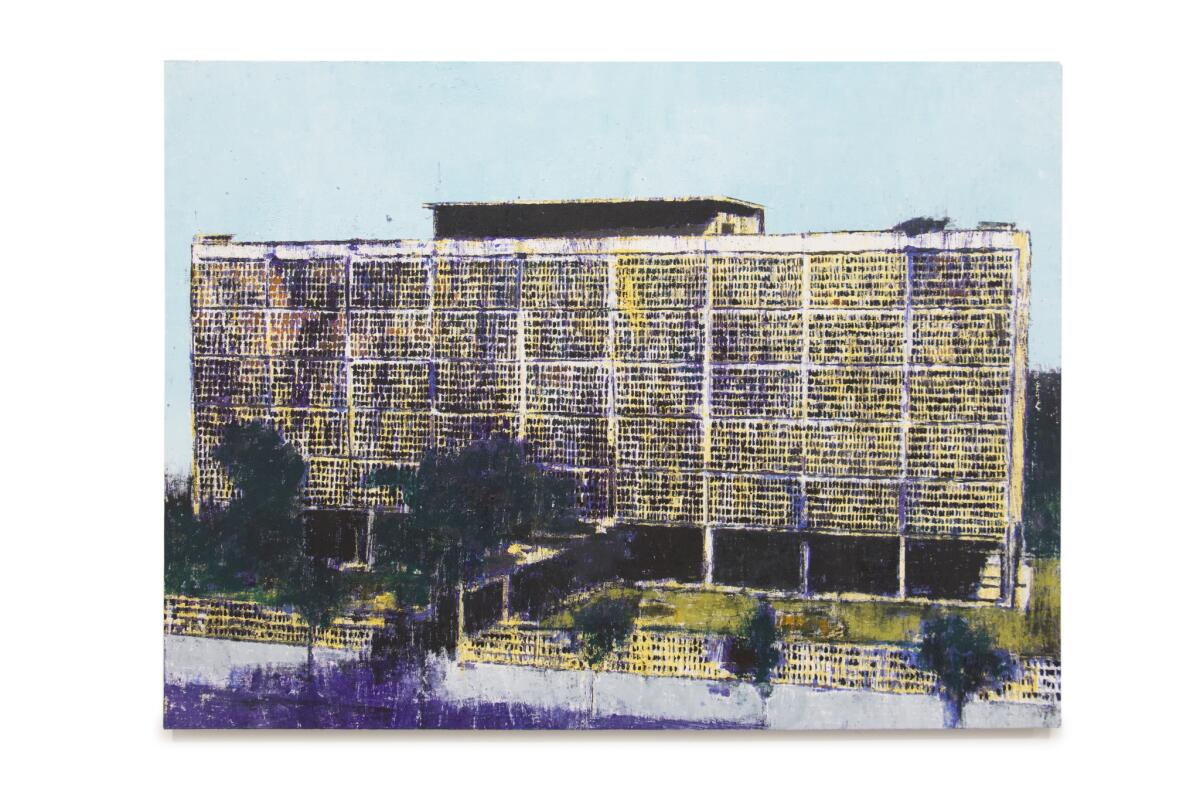
Caroll Dunham, at Blum & Poe. Over the course of his long-career, the New York/Connecticut-based painter has been creating works that depict the human figure in ways that are poetic and ribald. At Blum & Poe, he is showing three new interconnected bodies of work that focus on wrestlers — tussling, in close-up and their images rendered in profile. Also at the gallery is a show by L.A.-born, Chicago-based artist Tony Lewis, who is presenting a series of new drawings. Through June 17. 2727 S. La Cienega Blvd., Culver City, blumandpoe.com.
Ulrich Wüst, “Stadbilder / Nachlass,” at Christopher Grimes Gallery. The Berlin-based photographer is known for creating images that critique the ways in which cities were built and developed in East Germany. In this, his first U.S. gallery show, he is also showing a series of images that record the objects left behind in East Berlin after the
“Transporter,” at Kopeikin Gallery. A new group show at Kopeikin Gallery organized by Katie Shapiro and Sean Higgins explores the idea of the “transporter” as used in science fiction — the object or device that allow people to travel from one side of the galaxy to the other. The show, which digs into the idea of being able to re-materialize, features work by collagist Sean Higgins and video artist Nathaniel Klein, as well as the elaborate drawings of Debra Scacco. Through June 17. 2766 La Cienega Blvd., Culver City, kopeikingallery.com.
“Moholy-Nagy: Future Present,” at the L.A. County Museum of Art. This sprawling exhibition examines the career of the influential Bauhaus artist and teacher, known for stripping art down to fundamentals of color and shape. Moholy-Nagy was a polymath who worked in painting, printmaking, photography and industrial design, and the show gathers more than 250 works of his in all formats. Moreover, it will also feature his installation “Room of the Present,” a concept for an exhibition space that was never realized in his lifetime. Through June 18. 5905 Wilshire Blvd., Mid-Wilshire, Los Angeles, lacma.org.
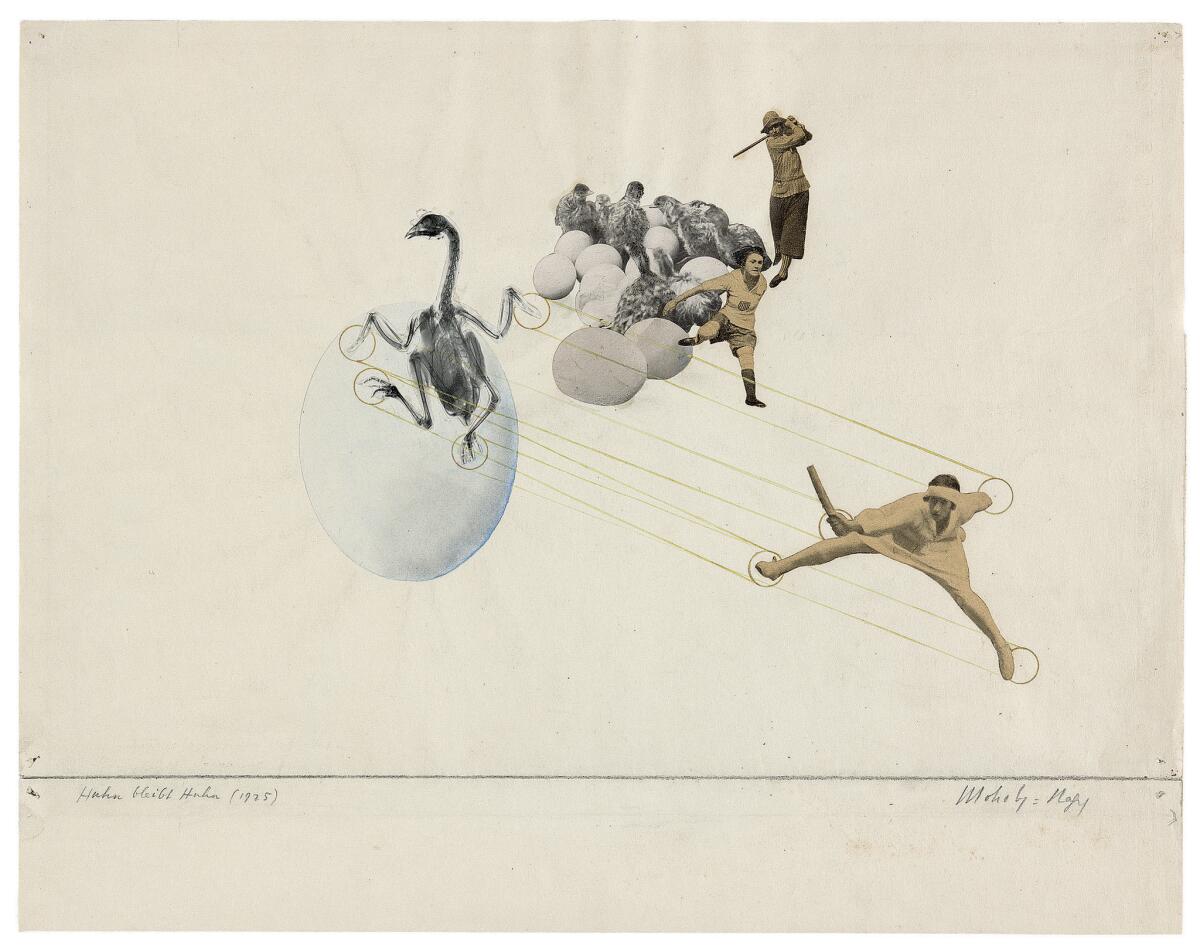
Young Joon Kwak, “Hermy,” and Patricia Fernández, “Box: a proposition for ten years,” at Commonwealth & Council. The gallery has a pair of new shows on view. The first features the sculptures and installations of Kwak, an artist who remakes everyday objects in visceral ways, and for this exhibition is inspired by the herma statues of antiquity, which generally consist of a head atop a column that bears genitalia. Fernández, in the meantime, is displaying a sculpture inspired by the history of Ruedo Ibérico books, a publishing company that served as a point of resistance to the dictatorship of Francisco Franco. Through June 24. 3006 W. 7th St., #220, Koreatown, Los Angeles, commonwealthandcouncil.com.
Todd Eberle, “Empire of Space,” at Wuho Gallery. The architectural photographer was recently awarded the 2017 JSI Excellence in Photography Award from Woodbury University and this exhibition gathers samples of his work. Based in New York, Eberle is known for producing images that are clean and minimal — a figure who began to draw attention after shooting Donald Judd’s art and furniture in Marfa, Texas, in the 1990s. Through June 25. 6518 Hollywood Blvd., Hollywood, wuho.architecture.woodbury.edu.
Sherin Guirguis, “My Place is the Placeless,” at the 18th Street Arts Center. The L.A.-based, Egyptian-born artist, who was recently part of the Desert X biennial in the Mojave, is currently in residence at the 18th Street Arts Center. On view is an installation that that comments on issues of displacement and environmental destruction, but in ways that fuse Western Modernism with Eastern architectural and design elements. Through June 30. 1639 18th St., Santa Monica, 18thstreet.org.
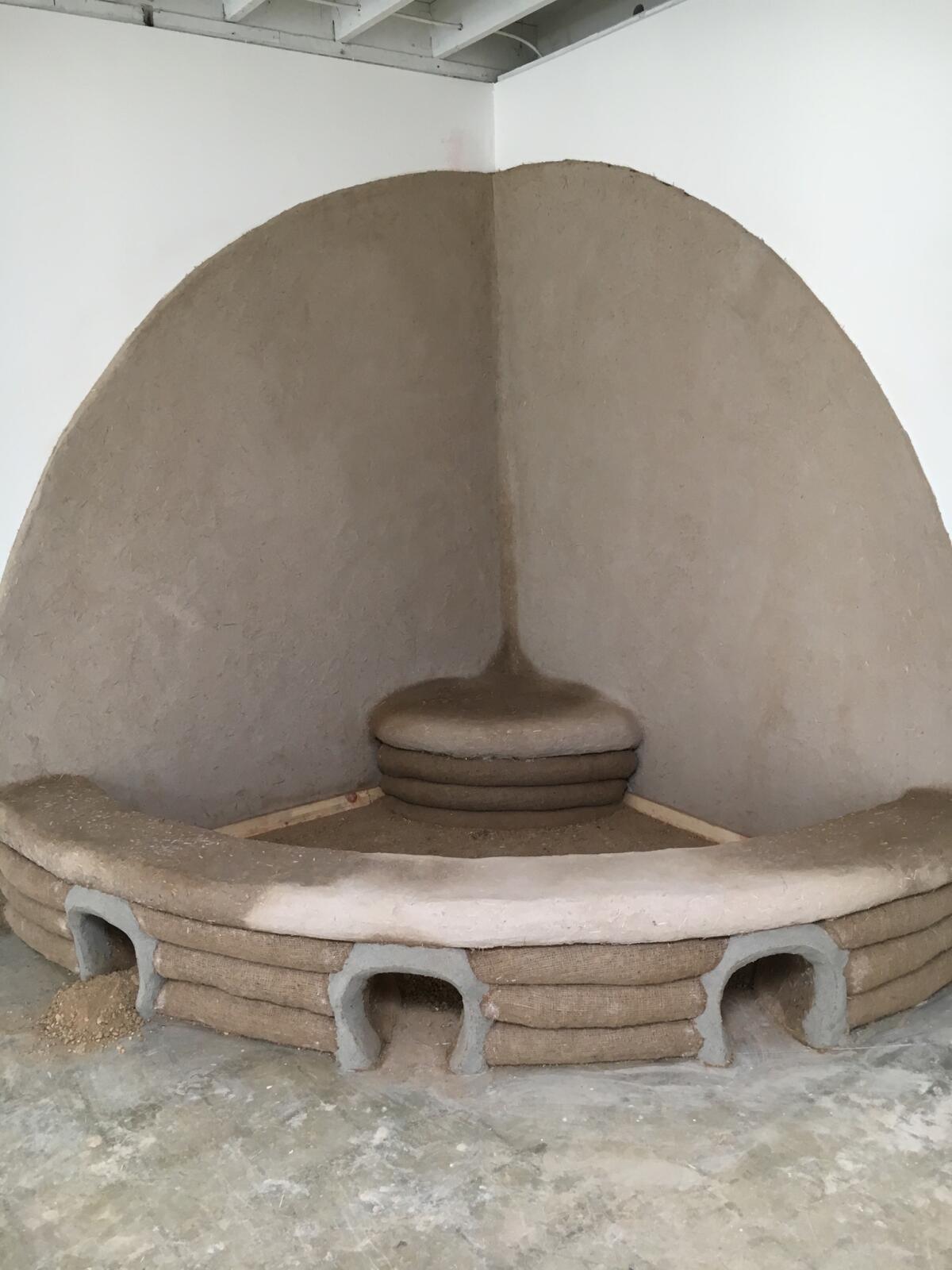
“L.A. 92: Decompressing History,” at Jean Deleage Gallery at Casa 0101. The 1992 L.A. uprising was recorded by countless professional photographers. It was also captured by everyday people wielding a camera. This exhibition gathers the images of L.A. resident Armando Cabrera, who was 24 when the riots unfolded in Los Angeles and captures the manifold moments of drama between the city’s residents and law enforcement. Through June. 2102 E. 1st St., Boyle Heights, Los Angeles, casa0101.org.
Lezley Saar, “Gender Renaissance,” at Walter Maciel Gallery. The Los Angeles artist creates paintings that hark back to Victorian styles (she often employs an oval format and places her work in antique frames) but adds flashes of the surreal and the contemporary. Her latest series looks at the complex topic of gender identity, inspired by her son’s transition from female to male. Also on view will be some large-format banners that feature portraits of defiant women on backdrops of quilted patterns. Through July 1. 2642 S. La Cienega Blvd., Culver City, waltermacielgallery.com.
“In Focus: Jane and Louise Wilson’s Sealander,” at the Getty Museum. For roughly three decades, twin sisters Jane and Louise Wilson have created large-scale photographs inspired by important events in European history — in the process, capturing the nuclear site at Chernobyl and the former headquarters of the East German secret police. In this series, they turn their attention to the brutal concrete bunkers deposited by Adolf Hitler along the French coast during
“Abdulnasser Gharem: Pause,” at the Los Angeles County Museum of Art. Gharem isn’t just an artist, he is also a lieutenant colonel in the Saudi Arabian army, the country where he was born and lives. His new show at LACMA, his first solo museum presentation in the U.S., brings together 11 works by the artist all made in the aftermath of Sept. 11. The work, which fuses contemporary art making styles with traditionally Islamic motifs, quietly ruminates on the nature of war and terror (two of the artist’s former classmates were hijackers). Through July 2. 5905 Wilshire Blvd., Mid-Wilshire, Los Angeles, lacma.org.
“Peter Shire: Naked Is the Best Disguise,” at the Museum of Contemporary Art. This survey looks at the work of the L.A.-based Shire, a key figure in Southern California’s “post-pottery” ceramics movement. The exhibition will display key work he did in the postmodern vein as part of Memphis, the Milan-based design collective — a group whose work was all about elaborate juxtapositions of bright colors and wild shapes. Also on view will be the artist’s handmade ceramic earthenware, crafted under the label Echo Park Pottery, and the work for which he is best known. Through July 2. MOCA Pacific Design Center, 8687 Melrose Ave., West Hollywood, moca.org.
Kerry James Marshall, “Mastry,” at the Museum of Contemporary Art. A 35-year retrospective, featuring nearly 80 works, examines the career of a painter who is known for depicting the black figure in ways that are mordant, lordly and defiant — as well as painterly in the most sublime ways. Born in Birmingham, Ala., but raised in L.A. during the civil rights and black power movements, Marshall paints historical events, the city (including bits of Los Angeles), domestic scenes and portraits in ways that counter the invisibility of the black figure in Western art. His people — rendered in the inkiest shades of black — command notice and authority. Consider this show a must-see. Through July 3. MOCA Grand Avenue, 250 S. Grand Ave., downtown Los Angeles, moca.org.
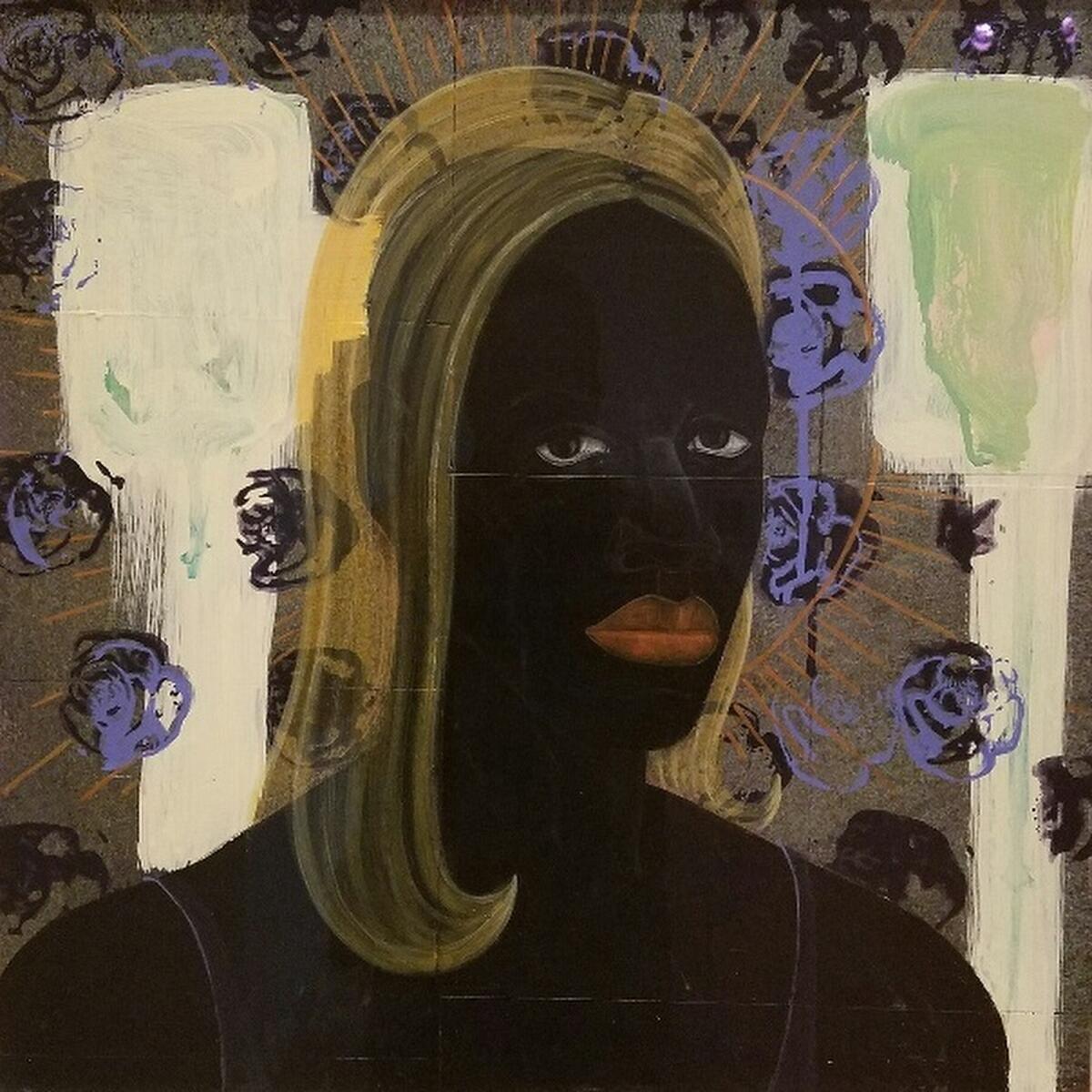
Richard Hamilton, Carlo Mollino and John Stezaker, “Blackout,” at Ibid Los Angeles. A new exhibition at Ibid brings together the works of three artists known for creating collages out of appropriated materials, be it a poster or pieces of photography. The show focuses on works that employ the human figure as a model in advertising, exploring questions of iconography, idealized beauty and consumerism. Also on view will be paintings by Christopher Orr and assemblages from the studio of James Herman. Through July 8. 670 S. Anderson St., Boyle Heights, Los Angeles, ibidgallery.com.
“The Inner Eye: Vision and Transcendence in African Arts,” at LACMA. A display of African art gathers objects that touch on important life transitions: initiation pieces, iconic masks and the reliquary guardians that guide people into the afterlife. The works on view, which include metalwork, sculpture and textiles, date from the 13th to 19th centuries and cover various African regions, including Mali, Nigeria, Liberia and Congo. Through July 9. 5905 Wilshire Blvd., Mid-Wilshire, Los Angeles, lacma.org.
Hammer Projects: Andrea Bowers, at the Hammer Museum. Bowers, an artist known for her activism, regularly broaches the subject in her work. This new installation was inspired by the artist’s involvement in the protests at Standing Rock — charting the connections between the international banking system and the construction of oil pipelines. She ties these to food and water issues at the Los Angeles level. Through July 16. 10899 Wilshire Blvd., Westwood, Los Angeles, hammer.ucla.edu.
“Chinese Ceramics From the Los Angeles County Museum of Art,” at the Vincent Price Art Museum.” Part of a new series of partnerships that will take LACMA works to other organizations around L.A., this show represents an overview of Chinese ceramics from the museum’s permanent collection that take the viewer from circa 2500 BC to the 19th century — as well as the museum’s own long history as a collector of Chinese ceramics. Through July 22. East Los Angeles College, 1301 Cesar Chavez Ave., Monterey Park, vincentpriceartmuseum.org and lacma.org.
“A Decolonial Atlas: Strategies in Contemporary Art of the Americas,” at the Vincent Price Art Museum. A group exhibition looks at the legacy of colonialism in everything from historical narratives to the struggle over human resources. The show is broken up into four sections that provide a distinctly indigenous view of identity, notions of time, relationship to the landscape (and the resources they hold) and how history is told and archived. Sounds like a show for our time. Through July 22. East Los Angeles College, 1301 Cesar Chavez Ave., Monterey Park, vincentpricemuseum.org.
Star Montana, “I Dream of Los Angeles,” at the Main Museum. Montana is an artist known for her stark, formally posed photographic portraits — a style she employs on the everyday denizens of Los Angeles, including people she meets on the streets in her native Boyle Heights as well as others that she has met through open calls. This show gathers various new works. The museum will also have an exhibition devoted to Alice Könitz’s prototypes for new types of museum seating. Through July 23. 114 W. Fourth St., downtown Los Angeles, themainmuseum.org.
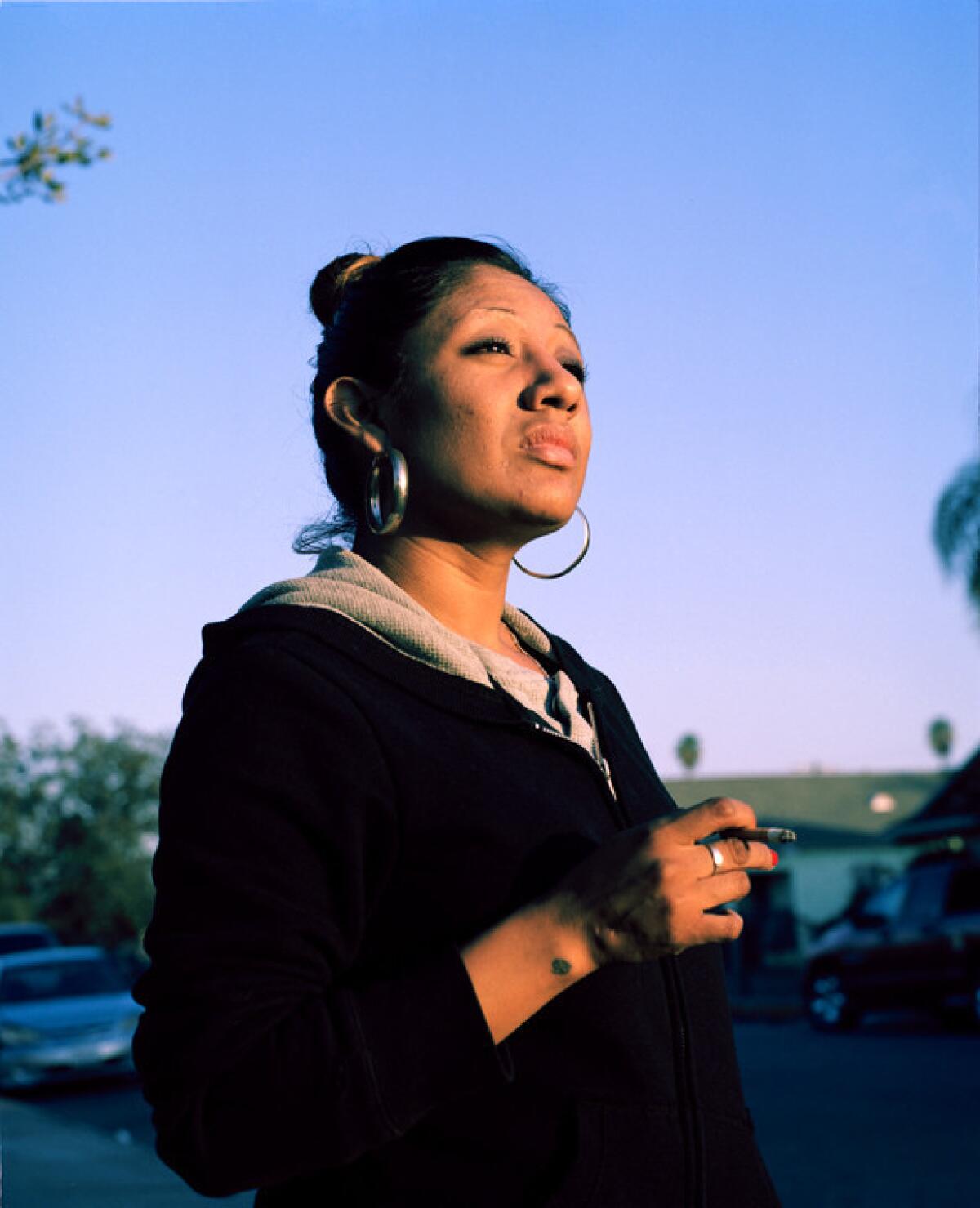
Carl Andre, “Sculpture as Place: 1958-2010,” at the Museum of Contemporary Art. This retrospective, which was first shown at Dia:Beacon in 2014, surveys the work of a sculptor known for creating minimalist installations out of raw building materials such as bricks, metal squares and wood blocks. The retrospective brings together pieces from throughout the artist’s five-decade career, including sculpture, photography, ephemera and his rare “Dada Forgeries,” a series of ready-made pieces that he has produced sporadically over the course of his life. Also opening at MOCA Geffen is a new film installation by award-winning filmmaker and artist Arthur Jafa, which traces questions of black identity employing found footage. Through July 24. 152 N. Central Ave., downtown Los Angeles, moca.org.
“Spiral Play: Loving in the ’80s,” at Art + Practice. Al Loving was an artist who drew on sources as varied as free jazz, his family’s quilting traditions and the history of Modern painting when creating abstracted works that riffed on color, form and flatness. But later in life, he turned his attention to depth, using heavy rag paper and other elements to create multidimensional collages infused with bold lines and bright color. This show, organized by Christopher Bedford, the new director of the Baltimore Museum of Art (formerlyof LACMA), features 12 of these late monumental collages. Through July 29. 3401 W. 43rd Place, Leimert Park, Los Angeles, artandpractice.org.
“Concrete Poetry: Words and Sounds in Graphic Space,” at the Getty Research Institute. This is an exhibition where words are about words, but also form. Starting in the mid 1950s, the movement known as concrete poetry sought to explore the space between poetry and visual art, creating works that were visual (words in shapes and 3-D form) but also played with the sound and cadence of language. This show features more than 100 works from the lead poets of the era, including Scotsman Ian Hamilton Finlay, the Brazilian Augusto de Campos and U.S. poets Mary Ellen Solt and Emmett Williams. Through July 30. 1200 Getty Center Drive, Brentwood, Los Angeles, getty.edu.
“Eyewitness News: Making History in Eighteenth-Century Europe,” at the Getty Museum. In the days before smartphones and cameras and even the daguerreotype, important public events were recorded through painting. This newly-opened show at the Getty has gathered works by the likes of Antonio Canaletto, Bernardo Bellotto, Giovanni Paolo Panini and others that record the important events of the era: a state visit between a king and a pope, the first hot air balloon flight ever recorded in Venice, Italy, and the damage suffered by the German city of Dresden after the Seven Years’ War of the 18th century. A new — or perhaps old? — way of looking at the news. Through July 30. 1200 Getty Center Dr., Brentwood, Los Angeles, getty.edu.
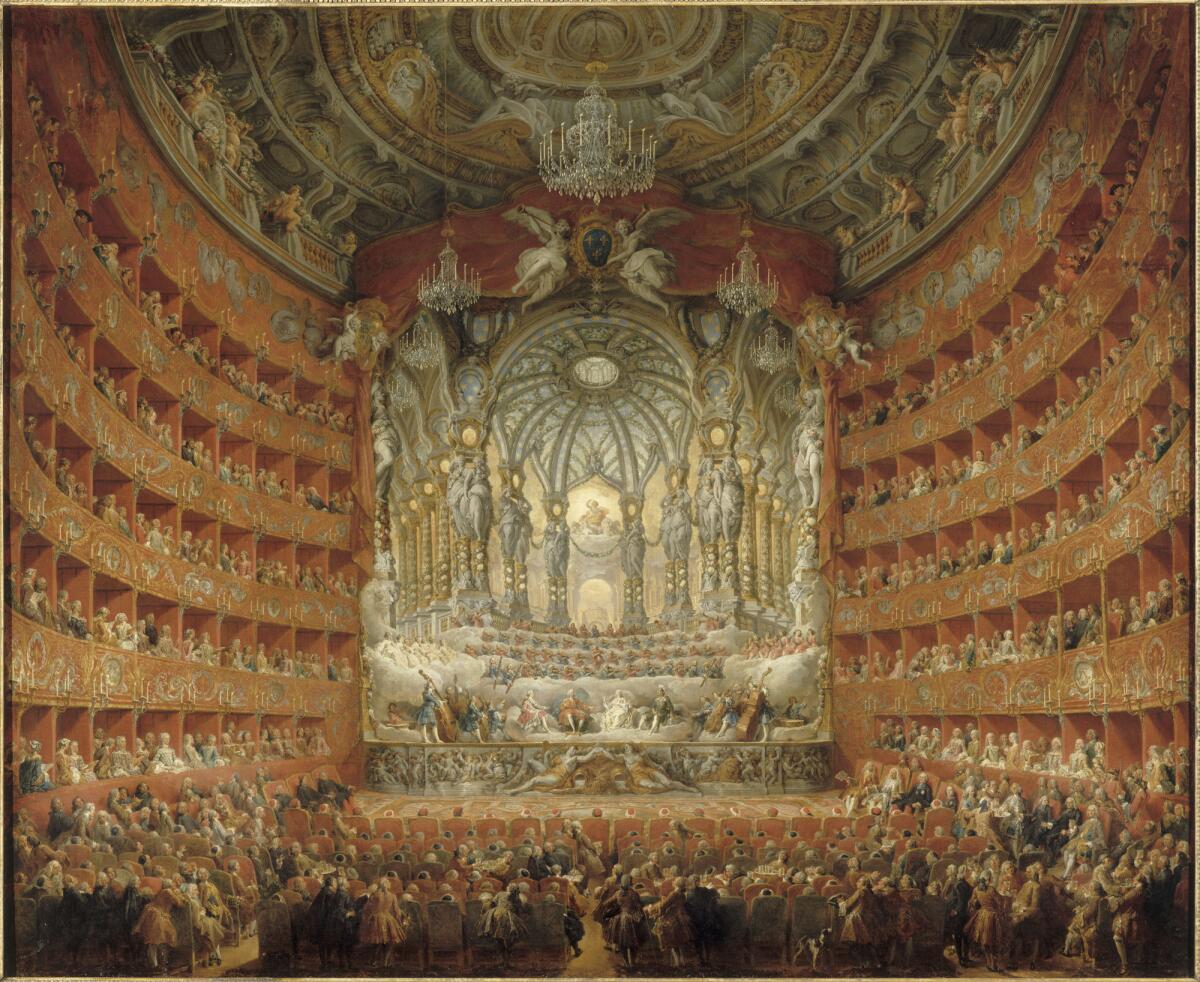
“Octavia E. Butler: Telling My Stories,” at the Huntington. Butler, the pioneering Los Angeles science fiction writer (the first to receive a MacArthur Fellowship, the so-called genius grant) and a writer whose narratives seamlessly blended issues of race and gender with elements of the magical, is the subject of a new exhibition on her life and work. This show at the Huntington (where her archive is kept) gathers roughly 100 items, including notebooks, photographs, journals and first editions of some of her novels, including “Kindred,” one of her best, most riveting works. Through Aug. 7. 1151 Oxford Road, San Marino, huntington.org.
“Instructions to All Persons: Reflections on Executive Order 9066,” at the Japanese American National Museum. At a time when executive orders are transforming U.S. society, it’s a good moment in which to study one of the most notorious ones: President Franklin D. Roosevelt’s Order 9066, which allowed for the incarceration of more than 120,000 Japanese Americans living along the West Coast during World War II. This exhibition brings together historical ephemera from this dark period in U.S. history, as well as works of art and performance that reflect on the issue of internment. Along with this, the museum is presenting “Moving Day,” a nightly public art piece in which exclusion orders are projected on the side of the building. Through Aug. 13. 100 N. Central Ave., downtown Los Angeles, janm.org.
Lauren Greenfield, “Generation Wealth,” at the Annenberg Space for Photography. Greenfield, a filmmaker and photographer, has long explored the issues of affluence and consumerism at the intersection of social status and celebrity culture. The exhibition features 195 color prints that depict the continual aspiration for more. Through Aug. 13. 2000 Avenue of the Stars, Century City, Los Angeles, annenbergphotospace.org.
“No Justice, No Peace: LA 1992,” at the California African American Museum. A historical exhibition looks at the myriad social and political forces that led to the 1992 riots in the wake of the Rodney King verdict — including a troubled history of police relations in minority communities, a history of housing segregation and the drug war, among other factors. Included in the show are hundreds of images and historic documents, as well as a zoot suit and a ’90s era police cruiser. Through Aug. 27. 600 State Drive, Exposition Park, Los Angeles, caamuseum.org.
“Frida Kahlo: Through the Lens of Nickolas Murray,” at the Museum of Latin American Art. For almost a decade in the 1930s and '40s, the Hungarian-born photographer Nickolas Murray photographed Mexican painter Frida Kahlo at home and at work. This exhibition gathers 46 black and white and color photographs of the Mexican artist, as well as copies of the correspondence they exchanged. Through Sept. 3. 628 Alamitos Ave., Long Beach, molaa.org.
2017 California Pacific Triennial, at the Orange County Museum of Art. The latest iteration of OCMA’s biennial looks at issues of architecture and urban design and their ever evolving features. This includes installations by 25 artists from throughout the Pacific Rim, including L.A.-based artist Olga Koumoundouros, known for working with fallow structures; Nancy Popp, who has studied issues of displacement related to the Olympics in Rio de Janeiro; Korea-born artist Haegue Yang, who employs elements of domestic architecture in elaborate installations; and Teddy Cruz, of Estudio Teddy Cruz, in collaboration with Fonna Forman, both of whom run the Cross-Border Initiative at UC San Diego. At a time in which space in cities is growing increasingly contested, it is an ideal time for a show of this nature. Through Sept. 3. 850 San Clemente Dr., Newport Beach, ocma.net.
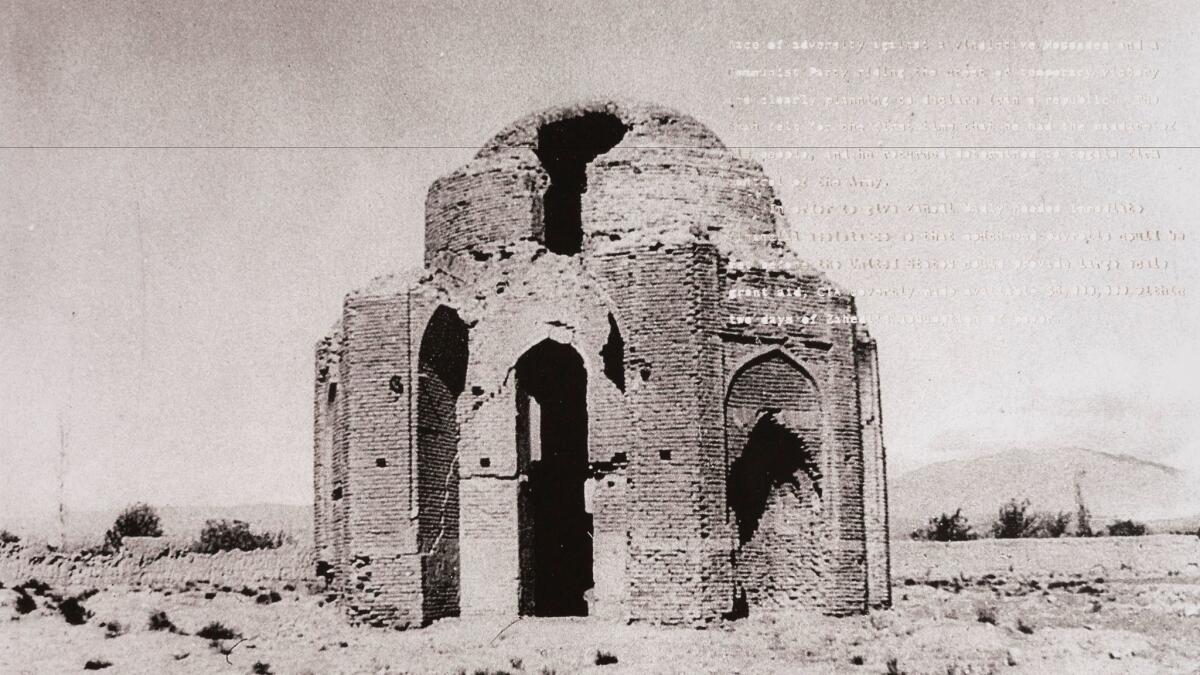
“Los Angeles to New York: Dwan Gallery, 1959-1971,” at the L.A. County Museum of Art. Previously on view at the National Gallery of Art in Washington, D.C., this exhibition tracks the legacy of one of the most important postwar galleries in the United States — a space that, for a time, operated in Los Angeles. Its proprietor, Virginia Dwan, wasn’t simply a run-of-the-mill gallerist, she was a patron, supporting artists with stipends and studios. She staged one of the earliest pop art exhibitions and she was an important supporter of minimalism. Plus, she was key in helping artists execute the most outrageous works — including important land art pieces such as Robert Smithson’s “Spiral Jetty.” Talk about thinking big. Through Sept. 10. 5905 Wilshire Blvd., Mid-Wilshire, www.lacma.org.
“Down and to the Left: Reflections of Mexico in the NAFTA Era,” at Armory Center for the Arts. A group exhibition featuring work by a range of Mexico and U.S-based artists takes as its point of departure the ’90s NAFTA years, a period of great change, when Mexico came out of a relative period of isolation, and when the local and the global became one. It was also a time when the Zapatista rebellion against the government had galvanized indigenous people and international audiences. Many of the works on view by artists such as Javier Téllez, Nao Bustamante, Lourdes Grobet and Pedro Mayer deal with this climate of economic and political unrest. Through Sept. 17. 145 N. Raymond Ave., Pasadena, armoryarts.org.
“Maven of Modernism: Galka Scheyer in California,” at the Norton Simon Museum. This exhibition examines the life of a key art dealer: Galka Scheyer, who embraced Modern work early in the 20th century and was partly responsible for bringing the artists known as the “Blue Four” to prominence in the United States. (They were Lyonel Feininger, Alexei Jawlensky, Paul Klee and Vasily Kandinsky.) Born in Germany in the late 19th century, she ultimately settled in California, where she lived in San Francisco and later in Hollywood, where she found an audience that was open to the work and its ideas. The exhibition contains work by the Blue Four, but also objects and other artworks that connect to Scheyer’s personal and professional life. Through Sept. 25. 411 W. Colorado Blvd., Pasadena, nortonsimon.org.
“Becoming America: Highlights From the Jonathan and Karin Fielding Collection,” at the Huntington Library. The Huntington has just redone its American art galleries and now features a new expansion by architects at Frederick Fisher and Partners that adds eight rooms for display. Up first is an exhibition devoted to the Fielding Collection, featuring more than 200 works of 18th and early 19th century American art, including paintings, furnishings and decorative art. Through Oct. 28, 2019. 151 Oxford Road, San Marino, huntington.org.
Sign up for our weekly Essential Arts & Culture newsletter »
Twitter: @cmonstah
The biggest entertainment stories
Get our big stories about Hollywood, film, television, music, arts, culture and more right in your inbox as soon as they publish.
You may occasionally receive promotional content from the Los Angeles Times.








